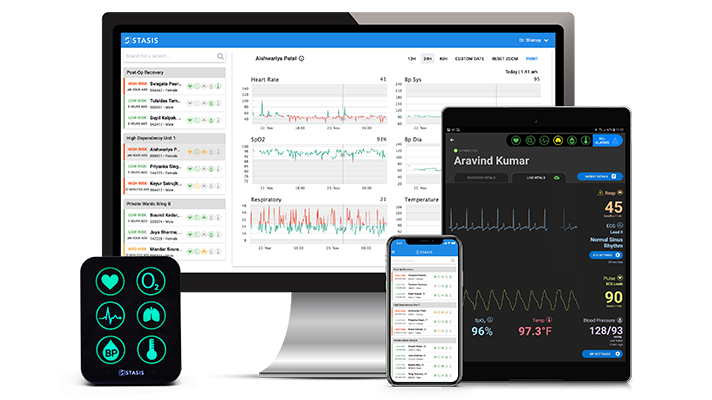
Stasis Labs announced today that its mobile-connected remote patient monitoring platform for hospital and outpatient use has launched in the U.S.
The Stasis system is made up of a smart device, traditional vital sign sensors, a bedside monitor and supporting cloud platform. Through mobile, tablet or desktop apps, care teams can monitor their patients' conditions, review trends and receive notifications when the system detects an issue. Stasis includes sensors measuring heart rate, blood oxygen, respiratory rate, blood pressure, temperature and three-lead ECG. It received a 510(k) clearance in April 2019.
Stasis Labs says that its platform has so far been rolled out in "approximately 50 cities," the majority of which are based in India. In the lead up to today's launch, the Cedars-Sinai Accelerator program alumni also deployed the system in a limited capacity to U.S. providers such as Texas-based emergency-care provider Hospitality Health ER and California-based Glendale Surgical Center and Orthopedic Surgery Specialists.
WHAT'S THE IMPACT?
Remote patient monitoring tools can help providers continuously monitor their patients without the need for direct contact with the patient. With little shortage of systems available on the market, the Stasis platform is leaning into app connectivity and ease of use as key differentiators for busy clinicians hoping to keep tabs on their patients.
“In the outpatient environment, clinicians are always on the move between facilities, and this level of connectivity to their patients and data tracking ensures clinical insights while on-the-move,” CEO Michael Maylahn said in a statement.
In testimonials provided by Stasis Labs, clinicians from Hospitality Health ER and Glendale Surgical Center stressed the ease with which their teams set up the devices for first-time use. The company also noted in the announcement that their system "only needs an intermittent power source to operate and minimal cellular service to the tablet and app."
THE LARGER TREND
Remote patient monitoring systems have become particularly appealing to providers as COVID-19 reinforces the need for stringent infection control and vacant hospital beds. Vendors have hinted at increased use of these devices in outpatient settings, while the FDA has opened the door for new Emergency Use Authorizations focused on connected health monitoring devices throughout the public health emergency.















